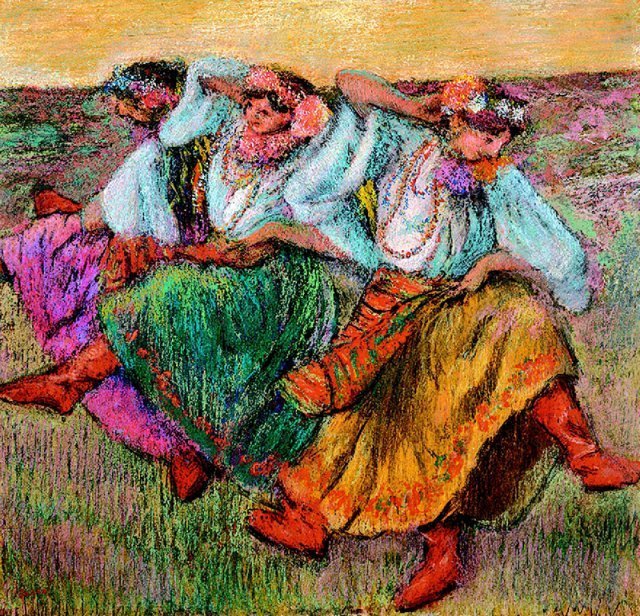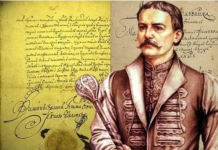New York museum has renamed an Edgar Degas painting to recognize its Ukrainian, not Russian, theme, and acknowledged formerly Russia-designated artists as Ukrainian.
Barley two months into Russia’s invasion of Ukraine, London’s National Gallery responded to criticism on social media and changed the name of a work by French impressionist artist, Edgar Degas, from “Russian Dancers” to “Ukrainian Dancers.”
Now, in response to ongoing pressure to recognize Ukrainian culture that had been colonized under the Tsarist and Soviet regimes, New York’s Metropolitan Museum of Art has renamed another Degas work.
The artwork known as “The Russian Dancer” was officially changed to “Dancer in Ukrainian Dress” last week as the Met also designated 19th century painters Ivan Aivazovsky, Ilya Repin and Arkhip Kuindzhi as Ukrainian, not Russian, artists.
“Step by step, Ukraine reclaims our cultural identity,” tweeted Anton Gerashchenko, adviser to Ukraine’s minister of internal affairs, in response to the retitling of the Degas work almost a year since the Russian invasion.
Artists recognized as Ukrainian
The recognition of Ukrainian artists at the Met was accompanied with the redrafting of captions on artworks.
“Kuindzhi was born along the coast in Mariupol, when the Ukrainian city was part of the Russian Empire,” reads the changed caption accompanying Kuindzhi’s circa 1905-08 painting, “Red Sunset” — which includes a view of Ukraine’s Dnipro River.
Mariupol was the site of fierce fighting during the initial invasion, and the destruction of cultural heritage including a museum named after the artist.
“In March 2022, the Kuindzhi Art Museum in Mariupol, Ukraine, was destroyed in a Russian airstrike,” the painting caption in the Met now reads.
A Met spokesperson told DW that it continually researches and examines objects in its collection in order to determine the most appropriate and accurate way to catalogue and present them.
“The cataloging of these works has been updated following research conducted in collaboration with scholars in the field,” read a statement.
Yet at time of publication, the Met is still to change the name of another Degas work in his series currently titled “Russian Dancers,” that is a very similar to the “Ukrainian Dancers” retitled by London’s National Gallery last year.
Degas works portray Ukrainian culture
“Dancer in Ukrainian Dress” is part of a series of pastel drawings that the French impressionist created from around 1890 to the early 1900s.
The series portrays Ukrainian women in traditional folk costumes with blue and yellow ribbons in their hair — the Ukrainian national colors.
Fascinated by dancers as a painting subject, it is believed Degas was inspired by Ukrainian dancers he had encountered while they were touring Paris.
At the time, France had entered an alliance with the Russian Empire that included Ukraine, and whose art and culture was on display in the French capital.
Failure to differentiate Russian and Ukrainian culture
When Ukraine was subjugated by the Russian and Soviet empires, so was its culture and heritage.
As part of what is known as the Ukrainian genocide, the Soviet regime lead by Josef Stalin quashed a rising independence movement by purging cultural figures and outlawing the Ukrainian language.
The Russification of Ukraine meant it was difficult to discern Ukrainian culture following independence in the early 1990s, said Daria Badior, a Ukrainian journalist and editor.
“In the media mainstream, few can discern whether an artwork was created in the Ukrainian, Georgian, Estonian, or the Russian Soviet Socialist Republic,” she wrote in the online art magazine, Hyperallergic. “It just seems, to the general public, like Soviet art and therefore Russian.”
“Every trip to a gallery or museum in London with exhibits on art or cinema from the USSR reveals deliberate or just lazy misinterpretation of the region as one endless Russia,” Olesya Khromeychuk, a historian, writer and director of the Ukrainian Institute London, wrote in German magazine, Der Spiegel, in March 2022.
“Curators have no problem presenting Jewish, Belarusian or Ukrainian art and artists as Russian,” she added, “much like the current president of the Russian Federation would like to see it.”
“Putin has one of the largest armies in the world, but he has other weapons too,” Khromeychuk wrote, adding that “culture and history take a prominent place in his arsenal.”
A report by the European Parliament also noted how Russia’s appropriation of Ukrainian culture has been a central part of the ongoing invasion.
“Russian aggressors have looted artifacts from public and private collections, added them to Russian collections and declared them part of Russian history and culture,” stated the report.
Other works in Degas series could be retitled
The renaming of the Degas series on Ukrainian dancers — which includes around 18 works — will depend on private owners and other museums who hold the works.
Two are at the Museum of Fine Arts, Houston, and one is in Sweden’s Nationalmuseum in Stockholm — a work which, according to the museum, has not been on display since 2019.
“Based on the information that is now available about the entire series of drawings that Degas made, there is reason for us to consider changing the title as well,” the Swedish museum told DW in a statement.
“First, we need to go through the information that the other museums have based their changes on and what a new title in that case would be.”
Ukraine’s struggle to de-Russify Ukrainian heritage and art is set to continue. [DW Original Article]










